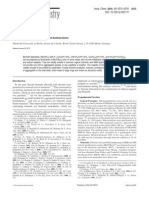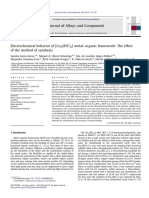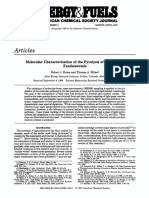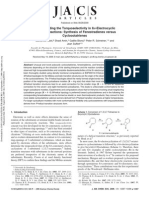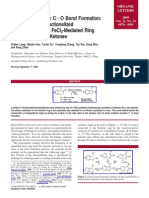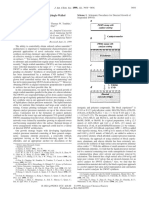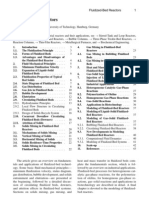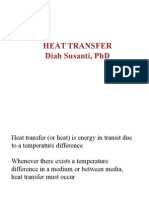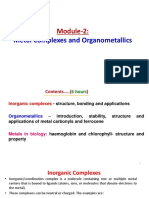Adsorptive Separation of Isobutene and Isobutane on Cu
3
(BTC)
2
Martin Hartmann,* Sebastian Kunz, Dieter Himsl, and Oliver Tangermann
Ad
V
anced Materials Science, Institute of Physics, Uni
V
ersity of Augsburg, Uni
V
ersita¨tsstr. 1, D-86159 Augsburg, Germany
Stefan Ernst and Alex Wagener
Fachbereich Chemie, Technische Chemie, TU Kaiserslautern, 67663 Kaiserslautern, Germany Recei
V
ed March 19, 2008. Re
V
ised Manuscript Recei
V
ed May 9, 2008
ThemetalorganicframeworkmaterialCu
3
(BTC)
2
(BTC
)
1,3,5-benzenetricarboxylate)hasbeensynthesizedusingdifferent routes: under solvothermal conditions in an autoclave, under atmospheric pressure and reflux, and byelectrochemical reaction. Although the compounds display similar structural properties as evident from the powderX-raydiffraction(XRD)patterns,theydifferlargelyinspecificsurfaceareaandtotalporevolume.Thermogravimetricand chemical analysis support the assumption that pore blocking due to trimesic acid and/or methyltributylammo-niummethylsulfate (MTBS) which has been captured in the pore system during reaction is a major problem for theelectrochemicallysynthesizedsamples.IsobutaneandisobuteneadsorptionhasbeenstudiedforallsamplesatdifferenttemperaturesinordertocheckthepotentialofCu
3
(BTC)
2
fortheseparationofsmallhydrocarbons.Whiletheisobuteneadsorption isotherms are of type I according to the IUPAC classification, the shape of the isobutane isotherm ismarkedlydifferentandclosertotypeV.Adsorptionexperimentsatdifferenttemperaturesshowthatasomewhathigheramount of isobutene is adsorbed as compared to isobutane. Nevertheless, the differential enthalpies of adsorption areonly different by about 5 kJ/mol, indicating that a strong interaction between the copper centers and isobutene doesnotdrivetheobserveddifferencesinadsorptioncapacity.Thecalculatedbreakthroughcurvesofisobuteneandisobutanereveal that a low pressure separation is preferred due to the peculiar shape of the isobutane adsorption isotherms. Thishas been confirmed by preliminary breakthrough experiments using an equimolar mixture of isobutane and isobutene.
1. Introduction
The design and synthesis of novel materials with tailor-madeproperties for applications in catalysis or separation by selectiveadsorptionremainanareaofintensiveresearch.Duetothequestfor improved materials for several applications, metal organicframeworks (MOFs) have received considerable attention inrecent years.
1–3
The combination of bi- or trifunctional linkerswithcoordinatingtransitionmetalionsorclustersisanattractivemethod for the synthesis of coordination polymers which offeraporous,clearlydefined,andhighlysymmetricstructure.MOFshave already been shown to offer potential in gas storage,
4
gasandliquidseparation,
5
drugrelease,
6
andheterogeneouscatalysis.
7
However, most studies so far have focused on gas adsorptionwith particular emphasis on molecular hydrogen storage.
8–13
Cu
3
(BTC)
2
(also known as HKUST-1, BTC
)
1,3,5-benzene-tricarboxylate) has been studied intensively since the first reportbyChuietal.in1999.
14
ThemainstructuralfeatureofCu
3
(BTC)
2
is a copper dimer with a copper
-
copper distance of 0.263 nm.Twelve carboxylate oxygen atoms from the two BTC ligandsbindtothefourcoordinationsitesofeachofthethreeCu
2
+
ions.These so-called paddle-wheel units form a face centered crystallatticewith
Fm
j
3
m
symmetrywhichpossessesathree-dimensionalchannelsystemwithabimodalporesizedistribution.Thelarger(hydrophilic) pores (diameter ca. 0.9 nm) are formed from 12paddle-wheel subunits forming a cuboctahedron. In addition tothecarboxylateligands,onewatermoleculeiscoordinatedtothecopper center pointing towards the center of the pore. Thecoordinated water molecules are removed in vacuum, creatingaccessible Cu
2
+
centers which can act as Lewis acid sites.
15
Asecondporesystemoftetrahedron-shapedsidepockets(diameterca. 0.5 nm) formed by four benzene rings is accessible from thelarge pores through windows with a diameter of 0.35 nm.
16
There have been continuous efforts to improve the synthesisand activation of Cu
3
(BTC)
2
.
17,15
The favored route to thesynthesis of high quality Cu
3
(BTC)
2
still is the hydrothermalsynthesis under autogenous pressure. However, this synthesisprocedure requires long reaction times, high temperatures, andmoderate pressures. Moreover, it should be mentioned that
* To whom correspondence should be addressed: Telephone:
+
49-821-598-3559. Fax:
+
49-821-598-3227. E-mail: martin.hartmann@physik.uni-augsburg.de.
(1) Eddaoudi,M.;Moler,D.B.;Li,H.L.;Chen,B.L.;Reineke,T.M.;O’Keeffe,M.; Yaghi, O. M.
Acc. Chem. Res.
2001
,
34
, 319
.
(2) Kitagawa,S.;Kitaura,R.;Noro,S.
Angew.Chem.,Int.Ed.
2004
,
43
,2334
.
(3) Rowsell, J. L. C.; Yagi, O. M.
Microporous Mesoporous Mater.
2004
,
73
,3
.
(4) Panella, B.; Hirscher, M.; Pu¨tter, H.; Mu¨ller, U.
Ad
V
. Funct. Mater.
2006
,
16
, 520
.
(5) Alaerts, L.; Kirschhock, C. E. A.; Maes, M.; van der Veen, M. A.; Finsy,V.; Depla, A.; Martens, J. A.; Baron, G. V.; Jacobs, P. A.; Denayer, J. F. M.; DeVos, D. E.
Angew. Chem., Int. Ed.
2007
,
46
, 4293
.
(6) Horcajada, P.; Serre, C.; Vallet-Regi, M. A.; Sebban, M.; Taulelle, F.;Ferey, G.
Angew. Chem.
2006
,
118
, 1
.
(7) Alaerts, L.; Seguin, E.; Poelman, H.; Thibault-Starzyk, F.; Jacobs, P. A.;De Vos, D. E.
Chem.
s
Eur. J.
2006
,
12
, 7353
.
(8) Yang, Q.; Zhong, C.
ChemPhysChem.
2006
,
7
, 1417
.
(9) Eddaoudi, M.; Kim, J.; Rosi, N.; Vodak, D.; Wachter, J.; O’Keefe, M.;Yaghi, O. M.
Science
2002
,
295
, 469
.
(10) Skoulidas, A. I.
J. Am. Chem. Soc.
2004
,
126
, 1356
.
(11) Vishnyakov, A.; Ravikovitch, P. I.; Neimark, A. V.; Bu¨1ow, M.; Wang,Q. M.
Nano Lett.
2003
,
3
, 713
.
(12) Krawiec, P.; Kramer, M.; Sabo, M.; Kunschke, R.; Fro¨de, D.; Kaskel, S.
Ad
V
. Eng. Mater.
2006
,
8
, 293
.
(13) Panella,B.;Hirscher,M.;Pu¨tter,H.;Mu¨ller,U.
Ad
V
.Funct.Mater.
2006
,
16
, 520.(14) Chui, S. S.-Y.; Lo, S. M.-F.; Charmant, J. P. H.; Orpen, A. G.; Williams,I. D.
Science
1999
,
283
, 1148
.
(15) Schlichte, K.; Kratzke, T.; Kaskel, S.
Microporous Mesoporous Mater.
2004
,
73
, 81
.
(16) Yang, Q.; Zhong, C.
J. Phys. Chem. B
2006
,
110
, 17776
.
(17) Liu,J.;Culp,J.T.;Natesakhawat,S.;Bockrath,B.C.;Zande,B.;Sankar,S. G.; Garberoglio, G.; Johnson, J. K.
J. Phys. Chem. C
2007
,
111
, 9305
.
8634
Langmuir
2008,
24,
8634
-
8642
10.1021/la8008656 CCC: $40.75
©
2008 American Chemical SocietyPublished on Web 07/09/2008
hydrothermalsynthesesarealsoproblematicwithrespecttoscale-up.Alternativesynthesisprocedureshavebeenattemptedinorderto find routes to faster and more efficient syntheses under evenless drastic conditions compared to the common hydrothermalsyntheses. At the moment, microwave synthesis,
18
electrochemi-cal synthesis,
19
and syntheses under reflux and stirring seem tobe suitable candidates for fast and practical synthesis methods.There are only few reports on the electrochemical synthesis
20
aswell as the ambient pressure route under reflux and stirring.
12,21
Moreover, it has been shown that the activation of the MOFmaterial is important for obtaining materials with high specificsurface areas and pore volumes.
17
In addition to routine characterization of the copper MOF bynitrogen adsorption at 77 K, adsorption of the noble gasesargon,
10,11,22
xenon,
23
and krypton as well as a continuousseparation of Kr and Xe were studied.
20
While the smaller noblegases argon and xenon are readily adsorbed on Cu
3
(BTC)
2
,krypton is too large to enter the MOF, which is the basis forefficient separation of Kr and Xe.
20
Cu
3
(BTC)
2
has been reported to be a suitable candidate forthe adsorption of hydrogen,
4,12,16,17
carbon dioxide,
16
and NO
21
aswellastheadsorptionandseparationofsmallerhydrocarbons.The adsorption of hydrocarbons on Cu
3
(BTC)
2
is so far limitedto methane, ethane, ethene, propane, and propene.
16,21,24
It isshownthatalkeneadsorptionispreferredoveralkaneadsorption.The continuous separation of propene and propane has beenstudied by Wagener et al.
24
A separation factor
R
propene/propane
of
∼
2 has been achieved. The preferential adsorption of propenein Cu
3
(BTC)
2
has been provisionally attributed to the strongerinteraction of the olefin with copper(II) species. The separationof olefins from the corresponding alkanes is an importantseparation problem at the interface between refinery andpetrochemistry.
25,26
The propane/propene separation is a veryenergy intensive process due to the close boiling points (
-
42.1
°
C vs
-
47.7
°
C) and the required number of separation stagesfor low temperature distillation. A suitable alternative is theselective adsorption on microporous adsorbents such as zeolites(e.g.,ITQ-12,
27
Si-Chabasite,
28
andAlPO
4
-14
29
)ormetalorganicframework materials.
30
In this work, we have concentrated on Cu
3
(BTC)
2
, since thisMOF possesses a free coordination site (after activation) at eachcopper center, which can be used for the reversible coordinationof molecules. We have explored the influence of the synthesisroute, namely, hydrothermal, ambient pressure, and electro-chemical synthesis, on the adsorptive properties of Cu
3
(BTC)
2
.ItisshownthatanovelambientpressuresynthesisofCu
3
(BTC)
2
using ethanol as the solvent yields the material with the highestspecific pore volume without using any specific activationprocedure. We have chosen isobutene and isobutane as modeladsorptives which possess similar sizes and very close boilingpoints(
-
6.9vs
-
11.7
°
C)butratherdifferentelectronicpropertiesdue to the double bond of isobutene. Isobutene and isobutanepossess a moderate dipole moment of 0.5
31
and 0.13 D,
32
respectively.Moreover,theadsorptionisothermswererecordedatdifferenttemperaturesinordertocalculatetheisostericheatofadsorption.We have found that the synthesis route has a significant effecton the adsorption and the related continuous separation of hydrocarbons such as isobutane and isobutene. It is moreoverobservedthattheinteractionofisobuteneandisobutanewiththeCu
2
+
ionsisrelativelyweak.However,thesignificantlydifferentshape of the respective adsorptions isotherms may allow aneffective separation of alkanes and olefins over Cu
3
(BTC)
2
.
2. Experimental Section
The synthesis of Cu
3
(BTC)
2
was carried out using differentprocedures as described below:(1)Hydrothermalsynthesis:Atotalof1.75gofCu(NO
3
)
2
·
3H
2
Oand 0.84 g of trimesic acid (H
3
BTC) were dissolved in 48 mL of EtOH. The suspension was filled into a Teflon container and placedinto an autoclave. The reaction was performed under autogenouspressure for 14 h at 120
°
C (sample A). In a second experiment,1.75gofCu(NO
3
)
2
·
3H
2
Oand0.84goftrimesicacidweredissolvedin a mixture of 24 mL of water and 24 mL of EtOH. The suspensionwasheatedunderautogenouspressurefor14hat120
°
CinaTeflon-linedautoclave(sampleB).Attheendofthereaction,theautoclavewascooleddowntoroomtemperature,andtheresultingbluepowderwas filtered off and washed once with water and then a second timewith EtOH. Thereafter, the sample was dried under vacuum at 100
°
C for 12 h and then kept under nitrogen atmosphere until furtheruse.(2) Synthesis under ambient pressure: A solution of 0.84 g of trimesic acid and 1.75 g of Cu(NO
3
)
2
·
3H
2
O in 50 mL of EtOH wasrefluxed under rigorous stirring. After a few hours, a blue solidstarted to precipitate. The synthesis mixture was kept under theseconditionsfor48handwassubsequentlycooledtoroomtemperature.The obtained blue powder was recovered by filtration, washed oncewithwaterandthenasecondtimewithEtOH.Thereafter,thesamplewas dried under vacuum at 100
°
C for 12 h and then kept under drynitrogen until further use (sample C).(3)Electrochemicalsynthesis:Theelectrochemicalsynthesiswasadopted from the patent literature and optimized in our laboratory.A typical synthesis was performed as follows: A total of 0.5 g of trimesic acid was dissolved in 60 mL of EtOH. An amount of 0.5 gof methyltributylammoniummethylsulfate (MTBS) was added tothe solution in order to increase the conductivity of the reactionmixture for electrolysis. Two copper electrodes were used in theelectrolysis cell, and a voltage of 15 V and current of 0.05 mA wereapplied.Afewminutesafterthestartoftheelectrolysis,abluesolidstartedtoprecipitatefromthesolution.After2h,thesolidprecipitatewas filtered off and washed one time with water and then a secondtime with EtOH. Afterwards the sample was dried under vacuumat 100
°
C for 12 h and then kept under nitrogen atmosphere (sampleD). In a second electrolysis experiment, 0.5 g of trimesic acid wasdissolved in a mixture of 30 mL of EtOH and 30 mL of water. Tothis solution, 0.5 g of MTBS was added in order to increase theconductivity of the reaction mixture for electrolysis. The solutionwas electrolyzed at 60
°
C using copper electrodes, a voltage of 15V, and a current of 0.05 mA. At the end of the reaction, the samplewas washed and dried as described above (sample E).All samples were routinely characterized by powder X-raydiffractionusingaSiemensD5000diffractometeroperatedat40kV
(18) Ni, Z.; Masel, R. I.
J. Am. Chem. Soc.
2006
,
128
, 12394
.
(19) Mu¨ller,U.;Pu¨tter,H.;Hesse,M.;Wessel,H.WO2005/049892,assignedto BASF AG, 2005
.
(20) Mu¨ller,U.;Schubert,M.;Teich,F.;Puetter,H.;Schierle-Arndt,K.;Pastre,J.
J. Mater. Chem.
2006
,
16
, 626
.
(21) Wang, Q. M.; Shen, D.; Bu¨low, M.; Lau, M. L.; Deng, S.; Fitch, F. R.;Lemcoff, N. O.; Semanscin, J.
Microporous Mesoporous Mater.
2002
,
55
, 217
.
(22) Lee, J. Y.; Li, J.; Jagiello, J.
J. Solid State Chem.
2005
,
178
, 2527
.
(23) Bo¨hlmann, W.; Po¨ppl, A.; Sabo, M.; Kaskel, S.
J. Phys. Chem. B
2006
,
110
, 20177
.
(24) Wagener, A.; Schindler, M.; Rudolphi, F.; Ernst, S.
Chem.-Ing.-Tech.
2007
,
79
, 851
.
(25) Eldridge, R. B.
Ind. Eng. Chem. Res.
1993
,
32
, 2208
.
(26) Ruthven, D. M.; Reyes, S. C.
Microporous Mesoporous Mater.
2007
,
104
, 59
.
(27) Olson, D. H.; Yang, X.; Camblor, M. A.
J. Phys. Chem. B
2004
,
108
,11044
.
(28) Olson,D.H.;Camblor,M.A.;Villasescusa,L.A.;Ku¨hl,G.H.
Microporous Mesoporous Mater.
2004
,
67
, 27
.
(29) Padin, J.; Rege, S. U.; Yang, R. T.; Cheng, L. S.
Chem. Eng. Sci.
2000
,
55
, 4525
.
(30) Pan, L.; Olson, D. H.; Ciemnolonski, L. R.; Heddy, R.; Li, J.
Angew.Chem., Int. Ed.
2006
,
45
, 616
.
(31) van Duin, A. C. T.; Baas, J. M. A.; van de Graaf, B.
J. Chem. Soc.,Faraday Trans.
1994
,
90
, 2881
.
(32) Laurie, V. W.
J. Chem. Phys.
1961
,
34
, 1516
.
Separation of Isobutene and Isobutane on Cu
3
(BTC)
2
Langmuir, Vol. 24, No. 16, 2008
8635
and30mAusingmonochromaticCuK
R
radiation(
λ
Cu K
R
)
0.15405nm). Scattering experiments were conducted at 2
θ
values from 4
°
to 50
°
with a step size of 0.1
°
. Nitrogen adsorption isotherms wererecorded at 77 K on a Micromeritics ASAP 2010 sorption analyzer.Prior to the measurements, the samples were outgassed for 12 h at100
°
C under vacuum. Thermogravimetric analysis was performedusing a Q 500 instrument manufactured by TA Instruments.Experiments were conducted with a constant heating rate of 20K/min in oxygen flow. The chemical analyses have been performedwith a Vario EL 3 elemental analyzer and vista-MPX CCDsimultaneous ICP-OES instrument both from Varian.The adsorption experiments with isobutane and isobutene wereconducted in a home-built volumetric adsorption apparatus. Allsamples were outgassed at 100
°
C prior to the measurements usinga turbo molecular pump (
p
<
10
-
7
hPa). UV
-
vis spectroscopy wasperformedonaPerkinElmerLambda18spectrometerinthediffusereflectancemodeusinga“PrayingMantis”accessory.Bariumsulfatewas employed as the standard.Thebreakthroughcurvesweremeasuredinafixed-bedflow-typeapparatus under atmospheric pressure. Prior to the breakthroughexperiments,theCu
3
(BTC)
2
powderwascarefullypelletized,crushed,and sieved to obtain particles with diameters between 230 and 350
µ
m. Thereafter, the sample was activated at 100
°
C in flowingnitrogen. As feed, an equimolar mixture of isobutene and isobutane(
p
)
5 kPa) in nitrogen (flow rate
)
36 cm
3
/min) was employed.The product stream at the outlet of the fixed-bed adsorber wasanalyzed on-line by gas chromatography using a flame ionizationdetector (FID).
3. Results and Discussion
3.1. PhysicochemicalCharacterization.
InFigures1and2,thepowderdiffractionpatternsofthesamplesA
-
Earecollected.AllpatternsareinniceagreementwithpowderX-raydiffraction(XRD)patternspublishedintheliterature
15,20
andwithasimulatedX-ray powder diffraction pattern which was calculated usingsinglecrystaldatapublishedbyChuietal.
14
ThesimulatedX-raypowder diffraction pattern is shown in Figure 3. Notably, twoadditional reflections at 2
θ
)
5.8
°
and 12.7
°
are observed forthe hydrothermally synthesized sample A and at 2
θ
)
11.0
°
forsample E synthesized electrochemically in an ethanol/watermixture. The two additional reflections observed for the sampleprepared by hydrothermal synthesis are also visible in a numberofliteratureXRDpatterns
15,24
butareabsentintheXRDpatternof sample C. This is indicative for the higher quality of thesample prepared under ambient conditions under reflux. It isimportant to point out that reflections attributable to CuO (2
θ
)
35.5 and 38.7
°
) or Cu
2
O (2
θ
)
36.43
°
) are absent from theXRD patterns of the samples employed in this study.The good agreement of the powder X-ray powder diffractionpatterns measured for our samples with the literature patterns aswell as with the simulated pattern calculated from the structureproposed by Chui et al.
14
confirms the successful synthesis of Cu
3
(BTC)
2
in all five cases. Thus, we assume that it is possibleto synthesize the skeletal structure of Cu
3
(BTC)
2
using differentprocedures. Scanning electron microscopy revealed that thesample is polycrystalline with particle sizes below 1
µ
m (FigureS1, Supporting information) for both the electrochemicallysynthesized material and the sample synthesized under ambientpressure. In agreement with the literature,
7,24
the particles fromthe hydrothermal synthesis are much larger (particle size of ca.10
µ
m).ThesignificantlysmallerparticlesizesofsamplesCandE are considered advantageous for envisaged application inseparation and catalysis in order to reduce diffusion limitations.The high-resolution (viz. in the low pressure region) nitrogenadsorption isotherms at 77 K on the different samples arecompared in Figure 4. Despite their seemingly similar structureas indicated by the XRD patterns, the nitrogen adsorption datayielding specific (Langmuir) surface areas ranging from 1150 to1620 m
2
/g and specific pore volumes between 0.43 and 0.62cm
3
/g are indicative of significant differences between the fivesamples (Table 1). As the specific surface areas are largelydependentonchoosingasuitablepartoftheadsorptionisotherm,
Figure1
.
XRDpatternsofCu
3
(BTC)
2
samplesA,C,andDsynthesizedin pure ethanol.
Figure2
.
XRDpatternsofsamplesBandEsynthesizedina1:1mixtureof ethanol and water.
Figure 3
.
Simulated XRD pattern of Cu
3
(BTC)
2
.
Figure4
.
Adsorptionofnitrogenat77KondifferentCu
3
(BTC)
2
samples.
8636
Langmuir, Vol. 24, No. 16, 2008 Hartmann et al.
wewillusethespecificporevolumeforthefollowingdiscussions.We have to note, however, that we calculated the specific porevolume at relative pressure
p
/
p
0
)
0.2, while often relative highrelative pressures
p
/
p
0
>
0.95 are used where the onset of condensationofnitrogenbetweentheparticlesmightgivehigherabsolute values. In the literature, specific pore volumes between0.3 and 0.83 cm
3
/g have been reported,
17
while the free porevolume from simulation as reported by Liu et al.
17
amounts to
∼
0.82 cm
3
/g. It is, thus, concluded that the differences inadsorption capacity observed for the samples studied are due todefectsand/orthepresenceofguestmoleculeslocatedinsidethepores. The presence of nitrates has been suggested by Mu¨ller etal.
20
for hydrothermally prepared samples, while the occlusionoftrimesicacidorsolventmoleculessuchasdimethylformamide(DMF) also has to be considered.Itisneverthelessclearthatthechoiceofsynthesismethodandsolvent significantly influences the product obtained and inparticular the adsorption properties. Different specific porevolumes and specific surface areas are observed. The largestspecific surface area is found for sample C which was preparedat ambient pressure in pure ethanol. In general, syntheses withethanol as solvent yield materials with higher specific porevolumes compared to those materials prepared in ethanol/watermixtures.ComparingsamplesA,C,andDleadstotheassumptionthat a longer reaction time is beneficial with respect to samplequality.SamplesBandEareinagreementwiththisobservation,although we have to point out that no particular activationprocedure was employed, since only ethanol and water wereused as solvents. In particular, the coprecipitation (and poreblocking) of trimesic acid and MTBS cannot be ruled out (videinfra). We would like to add that the synthesis of Cu
3
(BTC)
2
under ambient pressure in an ethanol/water mixture was alsoattempted but did not yield appreciable quantities of product.All five materials employed in the present study werecharacterized using thermogravimetric analysis (TGA). Inaddition,thegasflowattheoutletoftheTGovenwasmonitoredby IR spectroscopy. Prior to the TG experiment, the sampleswere dried under vacuum at 100
°
C for 24 h and subsequentlyrehydratedovernightinacontrolledwateratmosphereemployingadesiccatorinordertoensurethattheporesarecompletelyfilledwith water. The TG curves of the representative samples C andD are compared in Figures 5 and 6.Sample C shows a large weight loss between 50 and 120
°
C,which is ascribed to the desorption of water and is used todetermine the water content collected in Table 2. Thereafter, thesampleweightisreducedonlyslightlywithincreasingtemperatureupto300
°
C.Atthistemperature,thestructurecollapsesandtheorganic linker is burned, which is accompanied by the detectionof CO
2
by IR spectroscopy. For sample D, a first weight lossanalogous to the first weight loss observed for sample C isrecorded, although the relative amount of water desorbed issignificantlysmaller(Table2).Moreover,attemperaturesabove150
°
C, a second (creeping) weight loss is clearly visible untilthe structure collapses. Again, carbon dioxide is observed as adesorption product leaving the material. However, in additiontotheconductingsaltMTBS,theonlyorganiccompoundswhichhave been used for the syntheses are ethanol and trimesic acid.Ethanol has a boiling point of 78
°
C and, thus, is expected toleave the sample at temperatures lower than 160
°
C even if itisadsorbedinthepores.Sinceethanolisassumedtobedesorbedat lower temperatures, we tentatively ascribe the weight loss tomaterial which is located inside the pores of Cu
3
(BTC)
2
but isnot part of the framework itself. Since the only compounds usedfor the electrochemical synthesis besides ethanol are trimesicacid and MTBS, we assume that this additional weight loss isindicative for trimesic acid and MTBS occluded in the pores of the metal organic framework material. This assumption is alsoin line with the lower total pore volumes and lower specificsurface areas detected for the electrochemically synthesizedsamples as compared to the other samples in the present study.A similar TG curve was observed by Liu et al.
17
and ascribedto the slow release of DMF from the pore of Cu
3
(BTC)
2
.
Table 1
.
Textural Properties of the Cu
3
(BTC)
2
SamplesEmployed Is in the Present Study
syntheses procedurespecific porevolume (cm
3
/g)specific surfacearea (m
2
/g)sample A (autoclave synthesisin EtOH)0.57 1510sample B (autoclave synthesisin EtOH/H
2
O)0.47 1253sample C (synthesis inrefluxing EtOH)0.62 1624sample D (electrochemical synthesisin EtOH)0.50 1309sample E (electrochemical synthesisin EtOH/H
2
O)0.43 1153
Figure 5
.
TGA experiments of Cu
3
(BTC)
2
synthesized under ambientpressure in refluxing EtOH (sample C).
Figure6
.
TGAexperimentsofCu
3
(BTC)
2
synthesizedelectrochemicallyin EtOH (sample D).
Table 2
.
Chemical Analysis and Water Content Determined byTGA for the Cu
3
(BTC)
2
Samples Employed in the Present Study
materialCu content(wt %)C content(wt %)H content(wt %)molarratio
n
C
/
n
Cu
watercontent(wt %)sample A 34.80 34.44 1.66 5.2 15.55sample B 31.72 33.14 1.76 5.5 28.85sample C 31.56 36.90 0.95 6.2 26.75sample D 23.50 40.97 3.82 9.2 10.71sample E 24.33 39.61 3.19 8.6 12.38Cu
3
(BTC)
2
31.51 35.73 0.99 6.0
Separation of Isobutene and Isobutane on Cu
3
(BTC)
2
Langmuir, Vol. 24, No. 16, 2008
8637

















